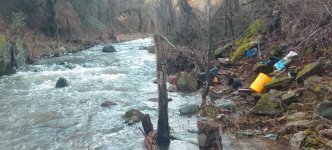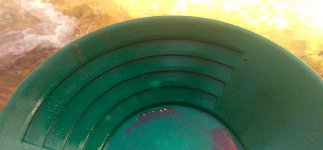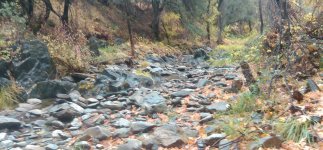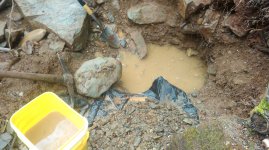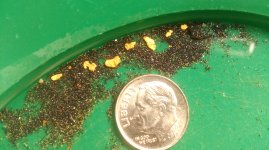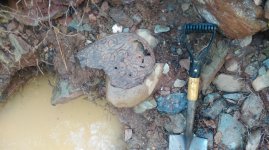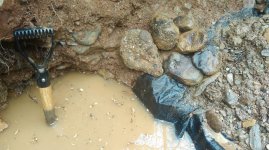Mitch Dickson
Jr. Member
- Mar 23, 2013
- 65
- 68
- Primary Interest:
- All Treasure Hunting
So you get a detector and go out to sling it a bit. Mostly they are useless  You will bring home much more gold detecting black sand pockets and panning those. You need no fancy detector to do that. Almost any old analog, manual ground balance will do just fine. I prefer an old metal box ElDorado.
You will bring home much more gold detecting black sand pockets and panning those. You need no fancy detector to do that. Almost any old analog, manual ground balance will do just fine. I prefer an old metal box ElDorado.
I do have a fancy Gold Strike that will find a pin head under a hot rock!!! But the engineer should be shot. He put in this low tone that goes off constantly in mineralized ground. It will however way outpace a gold bug any day. Now if you going up a wash or creek, in other words in aluvial your fine. Checking out veins your fine. Where you get into trouble is if you come across a nugget out on open ground!!! Most will hurry and hunt out the patch, maybe going home with an ounce or two. If so you destroy forever the clues that would lead you to the opening of a pocket. Gold in a weathered stringer pocket is measured in pounds not ounces!!!!! Most of them are not more than 6 feet deep. This is where the pros eat steak while you dine at McDonalds You must throw that detector down and go get the tools to find the entrance to that pocket!!!
You must throw that detector down and go get the tools to find the entrance to that pocket!!!
Me and my partner in our lives dug out two. The first bought me a brand new pickup and the second a 5 inch dredge!!!! Most people don't even know pocket gold exists, much less how to mine it. The Dutch were the experts at this. They wouldn't even come into a gold field till it was abandoned. Then take out a few rich pockets and move on. This was family secrets and no one outside was taught how. I alway wondered if the Lost Dutchman mine was really a mine or if he just took out a very rich pocket. Only book I ever knew that told you how was written by S.J. Cash in Australia in the 30s and 40s. He took out over 150 pockets in the down under in his lifetime making him a very very rich man!!!! The title is "Loaming for gold". Hey, they talk funny down there LOL! It's probably been out of print for 50 years
So watch that detector and don't let it cost you a new house LOL!
 You will bring home much more gold detecting black sand pockets and panning those. You need no fancy detector to do that. Almost any old analog, manual ground balance will do just fine. I prefer an old metal box ElDorado.
You will bring home much more gold detecting black sand pockets and panning those. You need no fancy detector to do that. Almost any old analog, manual ground balance will do just fine. I prefer an old metal box ElDorado.I do have a fancy Gold Strike that will find a pin head under a hot rock!!! But the engineer should be shot. He put in this low tone that goes off constantly in mineralized ground. It will however way outpace a gold bug any day. Now if you going up a wash or creek, in other words in aluvial your fine. Checking out veins your fine. Where you get into trouble is if you come across a nugget out on open ground!!! Most will hurry and hunt out the patch, maybe going home with an ounce or two. If so you destroy forever the clues that would lead you to the opening of a pocket. Gold in a weathered stringer pocket is measured in pounds not ounces!!!!! Most of them are not more than 6 feet deep. This is where the pros eat steak while you dine at McDonalds
 You must throw that detector down and go get the tools to find the entrance to that pocket!!!
You must throw that detector down and go get the tools to find the entrance to that pocket!!!Me and my partner in our lives dug out two. The first bought me a brand new pickup and the second a 5 inch dredge!!!! Most people don't even know pocket gold exists, much less how to mine it. The Dutch were the experts at this. They wouldn't even come into a gold field till it was abandoned. Then take out a few rich pockets and move on. This was family secrets and no one outside was taught how. I alway wondered if the Lost Dutchman mine was really a mine or if he just took out a very rich pocket. Only book I ever knew that told you how was written by S.J. Cash in Australia in the 30s and 40s. He took out over 150 pockets in the down under in his lifetime making him a very very rich man!!!! The title is "Loaming for gold". Hey, they talk funny down there LOL! It's probably been out of print for 50 years

So watch that detector and don't let it cost you a new house LOL!
Amazon Forum Fav 👍
Upvote
0


